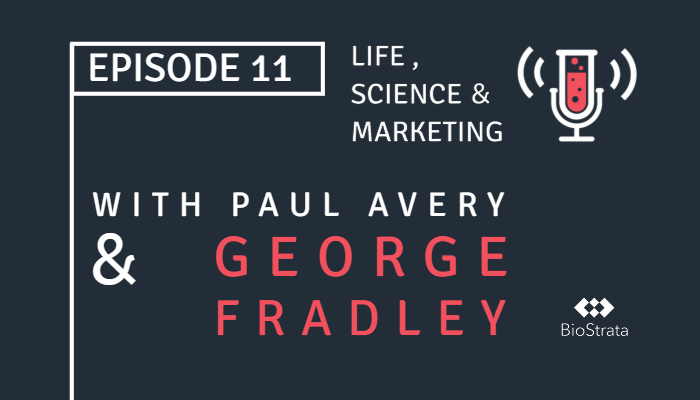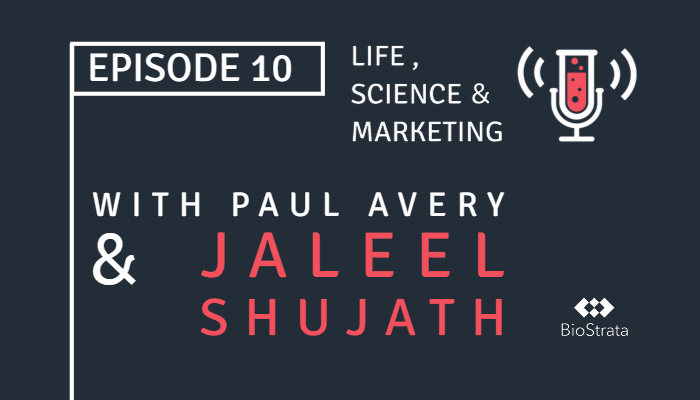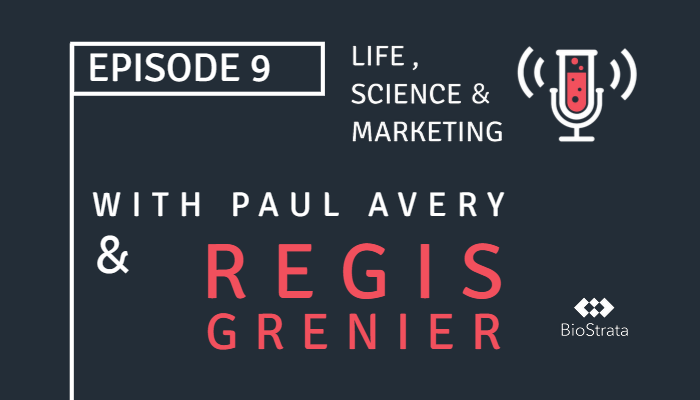George Fradley: Bringing the patient voice into marketing through empathy, storytelling, and visionary leadership
The "Life, Science and Marketing" podcast, hosted by Paul Avery, CEO of BioStrata, presents engaging conversations with leading marketing experts in the life sciences industry. Each episode features guests who discuss their personal journeys, experiences, and provide insights into the marketing strategies and practices that they have found effective during their career so far.
In this episode, Paul spoke with George Fradley, an independent marketing consultant with nearly 25 years in the life sciences industry. Beginning as a chemist, George discovered her talents for understanding patients’ perspectives and translating those insights into effective marketing and communications materials. In the episode, she discussed how deeply knowing your audience and crafting resonating stories are vital to effective marketing and thought leadership.
George also shared the value of her experiences working within companies that were pioneering visionary change in how clinical trials leverage technology. This required persistent credibility-building within an industry notoriously resistant to change, based on providing compelling proof points and authentic honesty. As she put it, you have to “add some sparkle” by sharing an ambitious vision of the future, while still being practical and authentic.
Read on for a recap of George’s interview in episode 11 and her insights on bringing the patient voice into marketing, using storytelling and empathy to connect, and leading industry change through visionary thought leadership. You can also listen to the full discussion in the podcast episode below (or find us on your favourite podcast platform).
How did you get to where you are today in your career?
George Fradley: I took a bit of a roundabout route into marketing. I actually started out as a chemist. I did a chemistry degree at Nottingham and just took a chemistry job because that's what I thought I had to do. I was lucky enough to end up at 3M, who back in those days had a pharmaceutical division, so I developed asthma inhalers with them. That was a great introduction to the industry, but I pretty quickly discovered that I'm really bad at chemistry and I don't have the tenacity to stand at a bench all day and conduct experiments and testing.
So over a couple of years, I naturally started to move away from the bench side and look at other areas I was really interested in and that people recognised I was good at. One thing I want to give kudos to 3M for is that they were really open to giving people opportunities according to the skills they displayed, as opposed to just their technical background.
Working with asthma inhalers, they're incredibly hard for patients to use correctly. So 3M gave me an interesting project - get a focus group of patients together and watch them using the inhalers. I have to say, it was one of the most interesting things I ever did. Over the next few years, I had that opportunity multiple times to learn different aspects of what patients were doing with the inhalers. I would sit and watch people of all ages and backgrounds using them, understanding what kinds of problems they had and why certain things were difficult or interesting.
That's really where I started, because I would go back and explain what I had learned to people in the labs and device development areas. I was bringing communication together from patients to device engineers and pharmaceutical scientists so everyone understood. That ability to understand another perspective and connect different sides is what set me on the path out of chemistry and into marketing.
What was the biggest difference between working at a global behemoth like 3M versus a smaller company like Exco InTouch?
George Fradley: I'm going to say autonomy. That's not to say 3M didn't give me opportunities to put my ideas forward, but with a big business, you have an established way of doing things and continuity across the organisation to consider. Whereas at Exco InTouch, we could really push forward the best approaches we felt were needed. I could explain why I felt a tactic or strategy was important, and everyone would get on board and then look for ways to improve it.
At Exco we were changing things constantly - put something out, see if it doesn't work, ask what else can we try, get something new and incorporate it. Really clever low-budget marketing, trying to maximise impact rather than following an accepted multi-year plan.
How did you establish credibility and get customers on board with Exco's vision for ePRO?
George Fradley: We were pushing something a bit outside people's comfort zones - using smartphones and ideally patients' own smartphones to collect clinical trial data. Pharma companies are risk averse and competitors didn't want ePRO to change because they wanted to protect their existing business model.
So we focused a lot on thought leadership, explaining why our way was okay and not risky. We had to combat early articles in the trade press from competitors about why it was dangerous, but around 2014-2015 there was a real shift. Suddenly competitors were copying what we said, which to me was the best compliment. It showed the industry recognised that ePRO had to change, so they changed strategy to service that need. And by reflecting our messaging, it actually strengthened the concepts in the industry's mind.
That ongoing credibility also came from consistent messaging with differentiation and honesty. We couldn't claim anything outright untrue, but we could add some "sparkle" with our vision for where ePRO should go. As we kept that credibility and lead, more customers truly got on board to help change ePRO processes. And once you have those early adopters, others gain confidence to follow.
What was an example of a successful campaign you ran that generated buzz?
George Fradley: When we launched the "Target My Hives" patient support app, we did something called a Thunderclap campaign across social media. It was a platform that let people sign up to post coordinated messages at the same time on launch day. We gave them the posts, and then at the designated time they all went out from hundreds of accounts.
It created instant noise and helped Target My Hives to start trending. I forget the exact number now, but we easily hit our sign-up goal to reach people. Once real patients with chronic urticaria started using the app, word of mouth took over and it snowballed from there. But the Thunderclap was a good way to make initial noise and get quick notice.
What’s the best process for creating effective thought leadership content?
George Fradley: I think the key is to stop thinking internally about what you want to say. Instead, put your focus externally on what your customers or influencers need to know about and understand right now and how your ideas can be relevant and beneficial to them.
It’s all about the story - lead people through a natural conversation that resonates. Make sure it flows to the points that matter. Use your understanding of the buyer to have that dialogue through content. Watch real conversations on places like LinkedIn to see people's actual concerns and perspectives.
Thought leadership shouldn’t just tell people what to think or regurgitate existing ideas. It should take concepts further and translate complex themes into ideas that regular people relate to and care about. It takes time for your audience to read your posts, so your content must provide true value. And it has to come from a place of deep experience that lends you credibility.
What do you see as the biggest ongoing challenge for life science marketers?
George Fradley: I think it’s cutting through the noise. We can all reach and communicate with the target audience quickly, which makes it easy for competitors to claim they can do the same things you do. So credibility is hard-won. You have to back up claims with honest and consistent messaging. And you need visibility - wide-reaching digital tactics are great, but also personal outreach when possible.
For example, I've seen clever use of direct mail to stand out when most communication is digital. It catches attention because it's unexpected and makes you feel special to receive an actual letter. That kind of creativity and understanding your audience helps lift you above the fray. And having a vision beyond the present shows you're truly leading as an authority.
Discover more insights with the Life, Science & Marketing Podcast
As we conclude this discussion with George Fradley, we’d like to thank her for openly sharing her marketing wisdom and experiences from across her career. George welcomes further conversations and questions via LinkedIn, so feel free to connect with her there to continue the dialogue.
Stay tuned for the next episode of "Life, Science and Marketing" where we’ll bring you another insightful discussion and actionable advice from a leading expert. You can also follow the official Life, Science and Marketing LinkedIn page to keep up-to-date with the latest podcast news and episodes.





